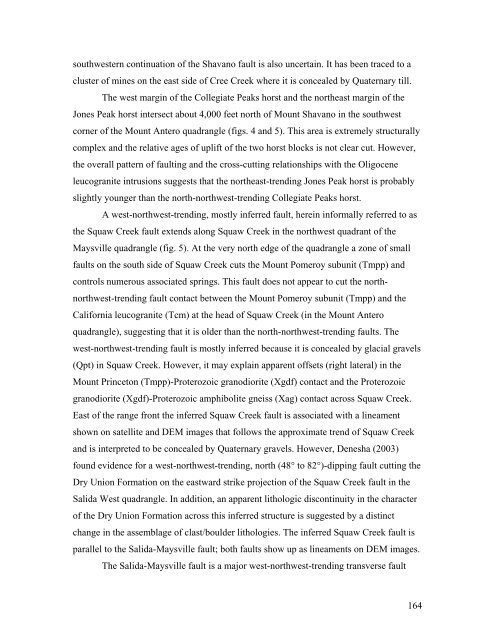Geologic Map of the Maysville Quadrangle, Chaffee County, Colorado
Geologic Map of the Maysville Quadrangle, Chaffee County, Colorado
Geologic Map of the Maysville Quadrangle, Chaffee County, Colorado
You also want an ePaper? Increase the reach of your titles
YUMPU automatically turns print PDFs into web optimized ePapers that Google loves.
southwestern continuation <strong>of</strong> <strong>the</strong> Shavano fault is also uncertain. It has been traced to a<br />
cluster <strong>of</strong> mines on <strong>the</strong> east side <strong>of</strong> Cree Creek where it is concealed by Quaternary till.<br />
The west margin <strong>of</strong> <strong>the</strong> Collegiate Peaks horst and <strong>the</strong> nor<strong>the</strong>ast margin <strong>of</strong> <strong>the</strong><br />
Jones Peak horst intersect about 4,000 feet north <strong>of</strong> Mount Shavano in <strong>the</strong> southwest<br />
corner <strong>of</strong> <strong>the</strong> Mount Antero quadrangle (figs. 4 and 5). This area is extremely structurally<br />
complex and <strong>the</strong> relative ages <strong>of</strong> uplift <strong>of</strong> <strong>the</strong> two horst blocks is not clear cut. However,<br />
<strong>the</strong> overall pattern <strong>of</strong> faulting and <strong>the</strong> cross-cutting relationships with <strong>the</strong> Oligocene<br />
leucogranite intrusions suggests that <strong>the</strong> nor<strong>the</strong>ast-trending Jones Peak horst is probably<br />
slightly younger than <strong>the</strong> north-northwest-trending Collegiate Peaks horst.<br />
A west-northwest-trending, mostly inferred fault, herein informally referred to as<br />
<strong>the</strong> Squaw Creek fault extends along Squaw Creek in <strong>the</strong> northwest quadrant <strong>of</strong> <strong>the</strong><br />
<strong>Maysville</strong> quadrangle (fig. 5). At <strong>the</strong> very north edge <strong>of</strong> <strong>the</strong> quadrangle a zone <strong>of</strong> small<br />
faults on <strong>the</strong> south side <strong>of</strong> Squaw Creek cuts <strong>the</strong> Mount Pomeroy subunit (Tmpp) and<br />
controls numerous associated springs. This fault does not appear to cut <strong>the</strong> northnorthwest-trending<br />
fault contact between <strong>the</strong> Mount Pomeroy subunit (Tmpp) and <strong>the</strong><br />
California leucogranite (Tcm) at <strong>the</strong> head <strong>of</strong> Squaw Creek (in <strong>the</strong> Mount Antero<br />
quadrangle), suggesting that it is older than <strong>the</strong> north-northwest-trending faults. The<br />
west-northwest-trending fault is mostly inferred because it is concealed by glacial gravels<br />
(Qpt) in Squaw Creek. However, it may explain apparent <strong>of</strong>fsets (right lateral) in <strong>the</strong><br />
Mount Princeton (Tmpp)-Proterozoic granodiorite (Xgdf) contact and <strong>the</strong> Proterozoic<br />
granodiorite (Xgdf)-Proterozoic amphibolite gneiss (Xag) contact across Squaw Creek.<br />
East <strong>of</strong> <strong>the</strong> range front <strong>the</strong> inferred Squaw Creek fault is associated with a lineament<br />
shown on satellite and DEM images that follows <strong>the</strong> approximate trend <strong>of</strong> Squaw Creek<br />
and is interpreted to be concealed by Quaternary gravels. However, Denesha (2003)<br />
found evidence for a west-northwest-trending, north (48° to 82°)-dipping fault cutting <strong>the</strong><br />
Dry Union Formation on <strong>the</strong> eastward strike projection <strong>of</strong> <strong>the</strong> Squaw Creek fault in <strong>the</strong><br />
Salida West quadrangle. In addition, an apparent lithologic discontinuity in <strong>the</strong> character<br />
<strong>of</strong> <strong>the</strong> Dry Union Formation across this inferred structure is suggested by a distinct<br />
change in <strong>the</strong> assemblage <strong>of</strong> clast/boulder lithologies. The inferred Squaw Creek fault is<br />
parallel to <strong>the</strong> Salida-<strong>Maysville</strong> fault; both faults show up as lineaments on DEM images.<br />
The Salida-<strong>Maysville</strong> fault is a major west-northwest-trending transverse fault<br />
164




